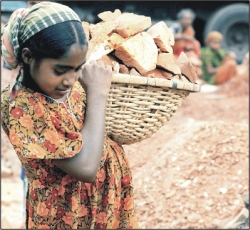Human Rights Advocacy
Child labor in Asia decreasing
The good news is that child labor in Asia is decreasing. The bad news? It's not declining fast enough. Despite a drop of about 5 million since 2000, working children number an estimated 122 million in Asia, or 64 percent of the worldwide total, according to the International Labor Organization. That's just slightly less than the entire population of Japan.
Though the causes of child labor are complex, the U.N. agency says a key problem is that there are too many people who, despite wanting their children in school, either can't afford fees or related costs like transportation and uniforms or would find it hard to get by without the extra income.
 In such an environment, many families send their kids to work -- in the fields, in factories, selling trinkets on the street or even in dangerous work sites like mines. ''The problem is the reduction in Asia is not as rapid as it should be,'' Panudda Boonpala, senior child labor specialist at the ILO, said in an interview. ''A large number of working poor means that we have a large number of people who are unable to support children to go to school.'' Child labor is one of the topics under discussion at the U.N. body's first Asian conference in five years. Under the theme of ''Realizing Decent Work,'' government representatives from 40 countries and territories as well as workers' and employers' organizations have been meeting this week to discuss issues such as youth employment, migration, globalization, competitiveness and productivity.
In such an environment, many families send their kids to work -- in the fields, in factories, selling trinkets on the street or even in dangerous work sites like mines. ''The problem is the reduction in Asia is not as rapid as it should be,'' Panudda Boonpala, senior child labor specialist at the ILO, said in an interview. ''A large number of working poor means that we have a large number of people who are unable to support children to go to school.'' Child labor is one of the topics under discussion at the U.N. body's first Asian conference in five years. Under the theme of ''Realizing Decent Work,'' government representatives from 40 countries and territories as well as workers' and employers' organizations have been meeting this week to discuss issues such as youth employment, migration, globalization, competitiveness and productivity.
Participants in a session on youth employment watched a short video on child labor, in which children were shown working at a gold mine in Mongolia. In a report on labor and social trends in the region, the ILO said that the number of child workers, defined as being between the ages of 5 to 14, in Asia fell to 122.3 million in 2004 from 127.3 million four years earlier.
South Asia, which includes Afghanistan, India, Pakistan, Bangladesh and Sri Lanka, remains a child labor hotspot, according to World Bank statistics contained in the ILO report.
Perhaps nowhere is the problem more acute than in Nepal, where as of 2004, accoriding to the ILO, nearly 40 percent of children aged 10-14 were working, sometimes for long hours and in jobs requiring strenuous physical labor such as in mines, quarries and carpet factories.
But even there, the statistics show improvement, with the percentage of children on the job declining from near 50 percent in 1990.
The Philippines, which has a national action plan crafted under ILO guidance, has also shown improvement, though problems remain in areas such as fireworks production, deep-sea fishing and mining. ''The laws are all there,'' said Undersecretary of Labor and Employment Manuel G. Imson. He added that the government is working to enforce them by cooperating with NGOs and national organizations like the police. Perceptions have also improved. ''I think 10 years ago there was lots of denial,'' the ILO's Panudda said. Further progress, however, depends on how much effort and resources Asian countries put into the fight, she added.
People who work as children also have less chance of securing good jobs in early adulthood because their lack of basic schooling makes it hard for them to receive skills in the form of vocational education.
The ILO is committed to ending what it calls the worst forms of child labor and abuse, which include slavery, using children in armed conflicts, trafficking in sex and drugs and hazardous labor, over the next 10 years.
Source:The New York Times.